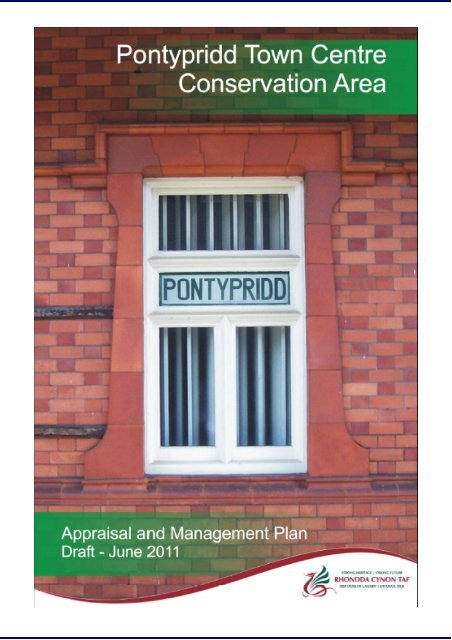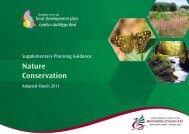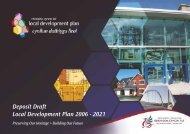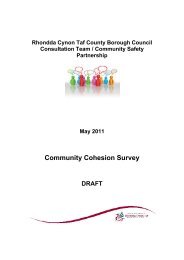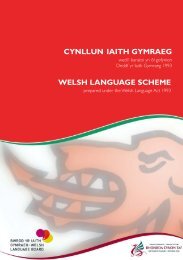Pontypridd Town Centre Draft Conservation Area Appraisal and ...
Pontypridd Town Centre Draft Conservation Area Appraisal and ...
Pontypridd Town Centre Draft Conservation Area Appraisal and ...
- No tags were found...
You also want an ePaper? Increase the reach of your titles
YUMPU automatically turns print PDFs into web optimized ePapers that Google loves.
RHONDDA CYNON TAF COUNTY BOROUGH COUNCIL<strong>Pontypridd</strong> <strong>Town</strong> <strong>Centre</strong> <strong>Conservation</strong> <strong>Area</strong>Character <strong>Appraisal</strong> <strong>and</strong> Management Plan<strong>Draft</strong> - March 2011This document has been prepared by Rhondda Cynon Taf County BoroughCouncil’s Regeneration <strong>and</strong> Planning Division.Images marked with * are reproduced by permission of Rhondda Cynon TafLibraries.<strong>Pontypridd</strong> <strong>Town</strong> <strong>Centre</strong> <strong>Conservation</strong> <strong>Area</strong>2
ContentsIntroduction 3Legal <strong>and</strong> Policy Context 3Status of the <strong>Appraisal</strong> 4Summary of the Special Interest of the <strong>Conservation</strong> <strong>Area</strong>Key Characteristics 5Location <strong>and</strong> Setting 6Historic Development 7Spatial AnalysisPlan Form <strong>and</strong> Layout 8L<strong>and</strong>marks, Focal Points <strong>and</strong> Views 9Buildings of the <strong>Conservation</strong> <strong>Area</strong> 10Listed Buildings 10Key Unlisted Buildings 12Character <strong>Area</strong> Analysis 131. Station Square 142. Gelliwastad Grove 153. Gelliwastad Road 184. Market Street <strong>and</strong> Church Street 205. Taff Street 226. Courthouse Street 247. Lower Taff <strong>and</strong> Mill Street 268. Penuel Square 279. Ynysangharad Park 29Management PlanFormat of the Management Proposals 31Key IssuesBoundary Changes 31Repair <strong>and</strong> Reinstatement of Historic Features 32Restricting Permitted Development Rights 34Works to Improve Public Realm 34Works to Improve <strong>Pontypridd</strong> Station 34Design <strong>and</strong> Layout of New Developments 35Monitoring 35Enforcement 35Materials 36Colours 37<strong>Pontypridd</strong> <strong>Town</strong> <strong>Centre</strong> <strong>Conservation</strong> <strong>Area</strong>3
IntroductionThe aim of this <strong>Conservation</strong> <strong>Area</strong> <strong>Appraisal</strong> <strong>and</strong> Management Plan is to assist inthe management of the <strong>Conservation</strong> <strong>Area</strong> in order to preserve <strong>and</strong> enhance thecharacter <strong>and</strong> appearance of the area, <strong>and</strong> conserve that special interest whichmakes it worthy of designation.<strong>Pontypridd</strong> <strong>Town</strong> <strong>Centre</strong> <strong>Conservation</strong> <strong>Area</strong> was designated in 1980 <strong>and</strong> revised in2001. The existing <strong>Pontypridd</strong> <strong>Conservation</strong> <strong>Area</strong> boundary consists of two partswhich are considered to contain attractive <strong>and</strong> important components of thetownscape within the town centre. This <strong>Appraisal</strong> <strong>and</strong> Management Plan proposesan extension of the <strong>Conservation</strong> <strong>Area</strong> boundary which will include most of the restof the town centre <strong>and</strong> Ynysangharad Park.This <strong>Conservation</strong> <strong>Area</strong> is distinct from the neighbouring Taff <strong>and</strong> Graigwen<strong>Conservation</strong> <strong>Area</strong>s, both of which will be the subject of appraisals <strong>and</strong>management plans at a later date.Legal & Policy Context<strong>Conservation</strong> <strong>Area</strong> designation is more concerned with the overall quality <strong>and</strong>interest of an area, rather than individual buildings, although it is common for suchareas to contain a number of Listed Buildings. Designation has a number ofimplications. Most importantly, the Council is required to give special attention topreserving or enhancing the character <strong>and</strong> appearance of the <strong>Conservation</strong> <strong>Area</strong> inexercising its planning functions.Local Authorities are under a duty to “formulate <strong>and</strong> publish proposals for thepreservation <strong>and</strong> enhancement of any parts of their area which are conservationareas” (Planning (Listed Buildings <strong>and</strong> <strong>Conservation</strong> <strong>Area</strong>s (LBCA)) Act 1990, s.71),<strong>and</strong> these should be reviewed from time to time.Policy Wales 4th Edition (February 2011) paragraph 6.3.2 also requires LocalAuthorities to formulate <strong>and</strong> publish proposals for the preservation or enhancementof <strong>Conservation</strong> <strong>Area</strong>s. A character appraisal assists this as it defines <strong>and</strong> analysesthe special qualities <strong>and</strong> the architectural <strong>and</strong> historic interest that warranted the<strong>Conservation</strong> <strong>Area</strong> designation. Section 6.3.3 states that “<strong>Conservation</strong> <strong>Area</strong>character appraisals can assist planning authorities in the exercise of their planning<strong>and</strong> development control functions”.The Rhondda Cynon Taf Local Development Plan (LDP) (adopted 2 nd March 2011)contains policies to guide development in the County Borough until 2021. Policy CS2 is a core policy setting out how sustainable growth will be achieved in theSouthern Strategy <strong>Area</strong> of the County Borough (including <strong>Pontypridd</strong>). One of thecriteria in the policy for achieving such sustainable growth is “protecting the culturalidentity of the Strategy <strong>Area</strong> by protecting the historic built heritage <strong>and</strong> the naturalenvironment”.Policy AW 7 relates to the protection <strong>and</strong> enhancement of the built environment,including <strong>Conservation</strong> <strong>Area</strong>s <strong>and</strong> their settings. It requires that developmentproposals are demonstrated to preserve or enhance the character <strong>and</strong> appearanceof such areas.Policy SSA 1 requires development in the town centre of <strong>Pontypridd</strong>, inter alia, torespect the culture <strong>and</strong> heritage of <strong>Pontypridd</strong>; to be of a high st<strong>and</strong>ard of design<strong>and</strong> to make a positive contribution to the townscape; <strong>and</strong> to contribute to the<strong>Pontypridd</strong> <strong>Town</strong> <strong>Centre</strong> <strong>Conservation</strong> <strong>Area</strong>4
enhancement of Ynysangharad Park.The Local Development Plan is accompanied by a set of Supplementary PlanningGuidance (SPG), which provides further details on certain aspects of planningpolicy. In particular, the “Design in <strong>Town</strong> <strong>Centre</strong>s” <strong>and</strong> “Historic Built Environment”SPGs are relevant to <strong>Pontypridd</strong> <strong>Town</strong> <strong>Centre</strong> <strong>Conservation</strong> <strong>Area</strong>.Status of the <strong>Conservation</strong> <strong>Area</strong> <strong>Appraisal</strong>The above policy documents are important considerations in determining planningapplications within the <strong>Conservation</strong> <strong>Area</strong> <strong>and</strong> its setting. This <strong>Appraisal</strong> is also animportant consideration <strong>and</strong> supports the above documents as it provides detailsabout the features <strong>and</strong> characteristics of the <strong>Conservation</strong> <strong>Area</strong> that make it <strong>and</strong> theproposed new areas special. It therefore sets out a context for considering thelocation <strong>and</strong> design of new developments within <strong>Pontypridd</strong> <strong>Town</strong> <strong>Centre</strong>, to ensureit “preserves or enhances” the area.The <strong>Appraisal</strong> also will form the basis for a <strong>Conservation</strong> <strong>Area</strong> Management Plan<strong>and</strong> the proposal to revise the <strong>Conservation</strong> <strong>Area</strong> boundary.<strong>Pontypridd</strong> <strong>Town</strong> <strong>Centre</strong> <strong>Conservation</strong> <strong>Area</strong>: boundary as existing<strong>Pontypridd</strong> <strong>Town</strong> <strong>Centre</strong> <strong>Conservation</strong> <strong>Area</strong>5
Summary of the Special Interest of the <strong>Conservation</strong><strong>Area</strong>Key CharacteristicsThis <strong>Appraisal</strong> of the <strong>Pontypridd</strong> <strong>Town</strong> <strong>Centre</strong> <strong>Conservation</strong> <strong>Area</strong> concludes that thefollowing are the key characteristics of the <strong>Conservation</strong> <strong>Area</strong>:Linear plan form <strong>and</strong> layoutSurrounding l<strong>and</strong>scape of steep valley sidesContinuous townscape of large scale buildings on Taff Street <strong>and</strong> MarketStreetDominance of late 19 th <strong>and</strong> early 20 th century architectureHigh quality examples of early 20 th century architectureThe Municipal Buildings, possibly the best piece of architecture in the<strong>Conservation</strong> <strong>Area</strong>Public open space in Ynysangharad ParkProminently sited railway station with high quality platform buildings19 th century planned street in Gelliwastad RoadConsistency of quality materials throughout the building stock of the<strong>Conservation</strong> <strong>Area</strong>* Taff Street in the late 19 th century, showing the Butcher’s Arms Hotel (now B&M Bargains)on the right.<strong>Pontypridd</strong> <strong>Town</strong> <strong>Centre</strong> <strong>Conservation</strong> <strong>Area</strong>6
Location <strong>and</strong> Setting<strong>Pontypridd</strong> sits centrally within the County Borough of Rhondda Cynon Taf,approximately 12 miles north of Cardiff, at the junction of the Rhondda <strong>and</strong> Taffvalleys. The <strong>Conservation</strong> <strong>Area</strong> encompasses the majority of the town centrecommercial area, while the surrounding valley sides contain residential developmentin three distinct areas – Graigwen, Graig <strong>and</strong> Glyntaff, each with distinctive 19 thcentury character. This topography has largely dictated the form of the developmentof the town, with the town centre developing alongside the rivers at the floor of thevalley, with steep residential districts climbing the hillsides.The wider community of <strong>Pontypridd</strong> has a population of about 30,000 people.<strong>Pontypridd</strong> in its wider context<strong>Pontypridd</strong> <strong>Town</strong> <strong>Centre</strong> <strong>Conservation</strong> <strong>Area</strong>7
Historic DevelopmentAt the mid-18 th century, the junction of the Taff <strong>and</strong> Rhondda rivers was a relativelyundeveloped, rural location which saw its first major development with the buildingof a bridge by William Edwards in 1756. After finally achieving success on the thirdattempt, Edwards’ bridge was the longest single-span bridge in the world when built,<strong>and</strong> the locality became known as Newbridge. Despite this architectural showpiece,it was not until the opening of the Glamorganshire Canal in 1794 that the areabegan to see significant development.Initially, the neighbouring settlement of Treforest saw the most development, with tin<strong>and</strong> iron works being in operation there. It was in 1818, with the opening of theNewbridge Chain, Cable <strong>and</strong> Anchor Works (later Brown Lenox), that realdevelopment started, with the location of the town making it an ideal place for amarket. The market is said to have been held on its present site since 1805.*Themarketinthe1920sThearrival of the Taff Vale Railway in 1841 put the town in an ideal position to benefitfrom the growing industrialisation of the valleys that stretch northwards from<strong>Pontypridd</strong>, with coal passing through the town on its way to the docks at Cardiff.Alongside this industrialisation, the town was developing in the form which largelysurvives intact today – Market Street, High Street <strong>and</strong> Mill Street are all mentionedin the 1841 census.In 1856 the town’s postmaster, Charles Bassett, achieved success in his campaignto change the name of the town from Newbridge back to <strong>Pontypridd</strong> (from Pont-y-typridd– bridge of the earthen house), <strong>and</strong> the town’s growth <strong>and</strong> success continuedundeterred throughout the remainder of the 19 th century, with a population of 6,000by 1871. By this time there were numerous chapels in the town, <strong>and</strong> a municipalcemetery opened in Glyntaff in 1871. Following this came the establishment ofnewspapers – the District Herald, the Chronicle <strong>and</strong> the Observer, <strong>and</strong> a populationof 20,000 by 1901.<strong>Pontypridd</strong> <strong>Town</strong> <strong>Centre</strong> <strong>Conservation</strong> <strong>Area</strong>8
The turn of the 20 th century was a time of great prosperity for the town, asevidenced in the survival of many buildings of quality from this period. The mostnotable, the Municipal Buildings, were designed by Henry Hoare of London <strong>and</strong>officially opened in 1906.A further key milestone in the history of <strong>Pontypridd</strong> was the opening ofYnysangharad War Memorial Park, which was laid out in the 1920s in an Edwardianstyle <strong>and</strong> opened in 1923. The Park survives largely intact today with many originalfeatures <strong>and</strong> buildings surviving, including one of the earliest lidos in South Wales.From the early – mid 20 th century onwards, <strong>Pontypridd</strong>’s building stock did not seesuch a high level of quality new development as previously. Some mid 20 th centurydevelopment, such as the demolition of Penuel Chapel its replacement withFraternal Parade, <strong>and</strong> the demolition of the arcade which once connected MarketStreet with Catherine Street, now seem ill advised <strong>and</strong> provide the potential for highquality new development. The town, in the early 21st century, still retains much of itsformer gr<strong>and</strong>eur in the building stock <strong>and</strong> street layout, which are to benefit frommajor public realm <strong>and</strong> townscape enhancement works beginning in 2011.<strong>Pontypridd</strong> <strong>Town</strong> <strong>Centre</strong> <strong>Conservation</strong> <strong>Area</strong>9
Spatial AnalysisPlan Form <strong>and</strong> Layout<strong>Pontypridd</strong> retains much of its original plan form <strong>and</strong> layout, which was clearlyheavily influenced by the topography of the area, in particular the locations of theRivers Taff <strong>and</strong> Rhondda. The line of Taff Street loosely follows the line of the RiverTaff, with development on its west side, while Mill Street, historically the principalroute from <strong>Pontypridd</strong> to the Rhondda Valleys, follows the River Rhondda from itsjunction with the Taff. Interestingly, neither road has properties which face therivers, <strong>and</strong> the town has a feel of having its back turned on these rivers. It isprobably that the rivers would have been rather dark <strong>and</strong> dirty at the time the townwas developing, due to the prominence of industrial activity in the area <strong>and</strong> thedisposal of pumped minewater directly in to the rivers, <strong>and</strong> as such they would havedetracted from the environment within the town.Market Street sits on an elevated piece of l<strong>and</strong> adjacent to Taff Street, <strong>and</strong> is thehistoric <strong>and</strong> present day site of the market. This location may have been chosen toavoid potential flooding lower down on Taff Street <strong>and</strong> Mill Street.The principal historic thoroughfare, Taff Street, now has traffic restrictions in place<strong>and</strong> Gelliwastad Road has replaced it as the main through-route for traffic. The lineof Gelliwastad Road has roughly the same linear form as Taff Street, emphasisingthe linear nature of the town’s layout.At the southern end of the <strong>Conservation</strong> <strong>Area</strong>, Broadway/Sardis Road is theprincipal thoroughfare <strong>and</strong> is essentially a modern route which follows the line of theformer tramway, replacing High Street which previously linked the town centre withthe Graig area of the town.The largest public space in <strong>Pontypridd</strong> town centre is Ynysangharad Park, whichsits on flat ground to the east of the town centre on the other side of the River Taff.The park is connected to the town by a footbridge at the southern end of Taff Street<strong>and</strong> the main road over Victoria Bridge at the northern end.<strong>Pontypridd</strong> <strong>Town</strong> <strong>Centre</strong> <strong>Conservation</strong> <strong>Area</strong>10
L<strong>and</strong>marks, Focal Points <strong>and</strong> ViewsIn the southern part of the <strong>Conservation</strong> <strong>Area</strong>, the former Clarence Hotel, recentlyknown as Angharad’s, provides a l<strong>and</strong>mark feature at this entrance to the town, withthe solid mass of the bingo hall behind. The northern elevation of the former bingohall (formerly County Cinema) completely dominates that end of Taff Street. Fromthe surrounding valleys, perhaps the most visually dominant feature of <strong>Pontypridd</strong> isSt Catherine’s Church, whose tower is prominent on the skyline of the town, inviews from the surrounding hills.Looking up Gelliwastad Road, with St Catherine’s Church on the leftWithin the town centre itself, focal points are provided at the junctions of Taff <strong>and</strong>Mill Streets, Taff Street <strong>and</strong> Penuel Lane <strong>and</strong> the two junctions between Taff <strong>and</strong>Market Streets. From within Taff Street, the large scale of the buildings gives thisstreet a sense of enclosure which is enhanced by an awareness of the steephillsides surrounding the town. From this <strong>and</strong> the surrounding streets, theneighbouring valley sides are a constant reminder of <strong>Pontypridd</strong>’s valley location.Streetscape vistas of note include that looking up Gelliwastad Road towards theimpressive presence of the Municipal Buildings, <strong>and</strong> those in both directions up <strong>and</strong>down Taff Street, where the scale <strong>and</strong> variety of building types give a real sense of<strong>Pontypridd</strong> <strong>Town</strong> <strong>Centre</strong> <strong>Conservation</strong> <strong>Area</strong>11
Victorian character to the street.Ynysangharad Park forms a principal l<strong>and</strong>scape focal point, <strong>and</strong> largely retains itscharacter as an Edwardian style public park.Buildings of the <strong>Conservation</strong> <strong>Area</strong>The <strong>Conservation</strong> <strong>Area</strong> covers a large part of the town centre of <strong>Pontypridd</strong>, <strong>and</strong> assuch there is a wide variety of building types <strong>and</strong> styles with the area. There arevery few residential buildings in the town centre itself, <strong>and</strong> the character is largelyderived from the commercial buildings which line the streets, <strong>and</strong> given the nature ofcommerce during the Victorian era when the town was developing, this character israther varied. Taff Street <strong>and</strong> Market Street are characterised by large, continuousscale commercial buildings of generally three or four storeys, while GelliwastadRoad <strong>and</strong> Grove contain substantial 19 th century terraced houses. Additionally,Gelliwastad Road contains four listed church buildings, giving that road a distinctcharacter which relates directly to the fact that it is one of the town’s few ‘planned’streets. The area around Station Square has seen incremental change over thecourse of the 20 th century <strong>and</strong> has lost some key buildings, but does retain someearly 20 th century key buildings. Courthouse Street contains good quality buildingsof both public <strong>and</strong> domestic character, <strong>and</strong> is a worthy addition to the <strong>Conservation</strong><strong>Area</strong>.<strong>Pontypridd</strong>’s buildings showcase a variety of materials. There is much Pennants<strong>and</strong>stone, often with brick dressings to window <strong>and</strong> door openings, <strong>and</strong> some withashlar dressings. Others, the Market Buildings for example, are built in yellow brickwith some red brick detailing <strong>and</strong> stone dressings to openings. Render is lesscommonplace in <strong>Pontypridd</strong> than stone <strong>and</strong> brick, but several prominent buildingssuch as the former Post Office in Station Square <strong>and</strong> the former bingo hall do haverendered elevations.<strong>Pontypridd</strong>’s overall character is of a 19 th century town with a number of goodquality early 20 th century buildings suggesting a period of economic success aroundthe turn of the century. The former Post Office in Station Square, the formerCriterion Public House, the Lido in Ynysangharad Park, <strong>and</strong> the <strong>Pontypridd</strong>Observer building in Market Street, as well as others, all exhibit an early 20 th centuryarchitectural confidence which is displayed in the level of high quality detail on theirfaçades.Although many buildings in the town centre have lost their original shopfronts orground floor elevations, the casual visitor will find, if they cast their eyes to theupper levels, that a surprising level of original historic features <strong>and</strong> detailing exists in<strong>Pontypridd</strong>, although they are now in need of some restorative attention.Listed BuildingsBuildings in Wales that are considered to be of national significance are added tothe Statutory List of Buildings of Special Architectural or Historic Interest, <strong>and</strong> thusbecome ‘Listed Buildings’. Listed buildings are protected by law <strong>and</strong> any works ofalteration, extension or demolition require express Listed Building Consent. Moreinformation can be sought from Rhondda Cynon Taf Council’s Regeneration <strong>and</strong><strong>Pontypridd</strong> <strong>Town</strong> <strong>Centre</strong> <strong>Conservation</strong> <strong>Area</strong>12
Planning Division.<strong>Pontypridd</strong> <strong>Town</strong> <strong>Centre</strong> <strong>Conservation</strong> <strong>Area</strong> has 29 statutorily listed buildings, threeof which are listed at Grade II*. These are St Catherine’s Church on GelliwastadRoad, the Municipal Buildings, <strong>and</strong> the Evan <strong>and</strong> James James Memorial inYnysangharad Park.The rest of this <strong>Conservation</strong> <strong>Area</strong>’s listed buildings are listed at Grade II.William Edwards’ Old Bridge, as mentioned earlier in this document, is both listed atGrade I <strong>and</strong> a Scheduled Monument, but falls within the Taff <strong>Conservation</strong> <strong>Area</strong>.* The Municipal Buildings, listed Grade II*The RegisterOffice onCourthouse Street(proposedextension to the<strong>Conservation</strong><strong>Area</strong>), listedGrade II<strong>Pontypridd</strong> <strong>Town</strong> <strong>Centre</strong> <strong>Conservation</strong> <strong>Area</strong>13
Key Unlisted BuildingsAs well as the <strong>Town</strong> <strong>Centre</strong> <strong>Conservation</strong> <strong>Area</strong>’s 29 listed buildings, there are alarge number of unlisted buildings which, while they may not meet the criteria fornational designation, can be of considerable local interest <strong>and</strong> are worthy ofretention. Such buildings make a strong contribution to <strong>and</strong> help to shape <strong>and</strong>define the character of the <strong>Conservation</strong> <strong>Area</strong>.Individual unlisted buildings of merit are identified in each Character <strong>Area</strong> analysissection, but those of particular worth in the context of the <strong>Conservation</strong> <strong>Area</strong> as awhole include -Former Post Office, Station SquareAshgrove HouseGelliwastad Grove terracesGelliwastad HouseFormer Butcher’s Arms HotelBarclays BankYnysangharad Park is included on the Cadw/ICOMOS UK Register of L<strong>and</strong>scapes,Parks <strong>and</strong> Gardens of Special Historic Interest in Wales at Grade II. Thisdesignation is a material consideration in the planning process.Character <strong>Area</strong> AnalysisFor the purposes of this <strong>Appraisal</strong>, the existing <strong>and</strong> proposed <strong>Conservation</strong> <strong>Area</strong>has been divided in to nine distinct character areas. The following section containsan analysis of each section individually.<strong>Pontypridd</strong> <strong>Town</strong> <strong>Centre</strong> <strong>Conservation</strong> <strong>Area</strong>14
Character <strong>Area</strong> 1: Station SquareThis area is the southern “gateway” to the town centre, <strong>and</strong> is dominated by thestation <strong>and</strong> its long, curved platform. The modern carriageway (Broadway/ SardisRoad) splits the character area <strong>and</strong> crosses the High Street, which slopes up the hillsouth west towards the Graig <strong>and</strong> downwards north into the town centre.Sardis Road <strong>and</strong> Broadway follow the route of a previous Tram Road linking tonearby collieries. There were several buildings next to the north east side of thestation that were demolished for road widening around 1990 (including the HalfMoon public house <strong>and</strong> White Palace cinema).As well as the station, the character area contains shops <strong>and</strong> other commercialpremises on Broadway <strong>and</strong> High Street, <strong>and</strong> the listed Sardis Chapel.Key Characteristics The unusual free Egyptian revival style architecture of the terracotta stationbuildings <strong>and</strong> its long platform, which was said to have been the longest inthe world when built. The terrace of commercial properties on the north east side of High Street<strong>and</strong> Broadway. Many of the buildings retain original historic details, including<strong>Pontypridd</strong> <strong>Town</strong> <strong>Centre</strong> <strong>Conservation</strong> <strong>Area</strong>15
the ornately detailed former Criterion Public House.Designated AssetsEglwys Gymraeg Sardis/ Sardis Chapel - Grade II<strong>Pontypridd</strong> Railway Station - Grade IIRailway Bridge beneath <strong>Pontypridd</strong> Railway Station - Grade IICriterion Public House (now Morgan’s Tavern) - Grade IIAn ornate gateway forming part of the Grade II listed platform buildings at <strong>Pontypridd</strong> StationUndesignated Assets Former Post Office Building (now Wetherspoon’s Public House) Former Clarence Hotel (Angharad’s Building) Former County Cinema (Bingo Hall) Former White Hart Public House (now Soul Suite)Opportunities for EnhancementImprovement of shopfronts, including removal/ replacement of inappropriatesignsWorks to improve the quality/ maintenance of the stationImproving the station’s relationship with the rest of the town centreImprovement of the public realmRe-use of vacant buildingsImprovement of signage on commercial properties<strong>Pontypridd</strong> <strong>Town</strong> <strong>Centre</strong> <strong>Conservation</strong> <strong>Area</strong>16
st Office building (above), a key unlistedlding within the <strong>Conservation</strong> <strong>Area</strong>,ich retains original features includingst iron hoppers (right).TheformerPobuiwhcaCharacter <strong>Area</strong> 2: Gelliwastad GroveThis area, which is a proposed addition to the <strong>Conservation</strong> <strong>Area</strong>, was developed inthe latter half of the 19 th century <strong>and</strong> mostly contains large Victorian residentialdwellings. The majority of buildings are still in use as residential properties, howeverthe area also includes Council Offices (Llwyn Castan) <strong>and</strong> the town’s library.The area is centred around Gelliwastad Grove which is an important link betweenthe town centre <strong>and</strong> the Victorian suburb of Graigwen. The main terrace on the roadis to the west of Gelliwastad Grove <strong>and</strong> elevated overlooking the town. The library<strong>and</strong> Llwyn Castan are to the north-east of Gelliwastad Grove <strong>and</strong> are accessedfrom Library Road. Gelliwastad Grove rises up <strong>and</strong> over the railway line. AshgroveHouse is a large Victorian house which is currently (2011) being restored to a singleresidence after a period of office use. Ashgrove House is situated at the same levelas nos. 1 – 11 Gelliwastad Grove <strong>and</strong> is therefore much higher than l<strong>and</strong> to thesouth <strong>and</strong> east.Key Characteristics<strong>Pontypridd</strong> <strong>Town</strong> <strong>Centre</strong> <strong>Conservation</strong> <strong>Area</strong>17
Dominant pair of three storey terraces on elevated siteOn the eastern side of Gelliwastad Grove, between this road <strong>and</strong> LibraryRoad, the area is partially dominated by a stone retaining wall withGelliwastad Grove on the upper level.The library – a distinctive 19 th century public buildingAttractive stone boundary walls <strong>and</strong> large mature trees* An historic photograph showing the terraces on Gelliwastad GroveDesignated AssetsThere are no listed buildings or scheduled monuments within this characterarea.Undesignated AssetsThe library, with its ornamental bust of ShakespeareAshgrove HouseAttractive retaining walls <strong>and</strong> terraced gardensWide variety of mature trees <strong>and</strong> shrubbery on Gelliwastad GroveOpportunities for EnhancementReinstatement of lost historic featuresRemoval/ improvement of unsympathetic dormers, extensions, outbuildings<strong>and</strong> boundary treatments.<strong>Pontypridd</strong> <strong>Town</strong> <strong>Centre</strong> <strong>Conservation</strong> <strong>Area</strong>18
The bust of William Shakespeare above the original entrance to <strong>Pontypridd</strong> LibraryCharacter <strong>Area</strong> 3: Gelliwastad RoadGelliwastad Road forms a major thoroughfare within the town centre. It was laid outtowards the end of the 19 th century linking Catherine Street in the south with MorganStreet in the north, crossing previously undeveloped l<strong>and</strong> associated withGelliwastad House. The new road created an alternative north-south link through<strong>Pontypridd</strong>, altering its historically linear form which traditionally focussed movement<strong>and</strong> development on Taff Street.Large houses along with religious <strong>and</strong> civic buildings developed along the road,which mostly still remain. The street has now been incorporated into the central areaof <strong>Pontypridd</strong>, with professional offices replacing residential uses.The construction of the Sardis Road Bridge in 1967 the widening of GelliwastadRoad to three lanes in 1990-93, <strong>and</strong> the introduction of traffic restrictions on TaffStreet in recent years, have made Gelliwastad Road the main vehicular routethrough the town centre.<strong>Pontypridd</strong> <strong>Town</strong> <strong>Centre</strong> <strong>Conservation</strong> <strong>Area</strong>19
Key CharacteristicsA broad, straight street with consistent architectural style <strong>and</strong> a planned <strong>and</strong>formal character, in contrast to surrounding, older streets;The street is lined with late 19 th century terraced houses with individualdetailing, generally constructed with pennant stone with brick or stonedetailing;Most houses have small front gardens bounded by stone walls <strong>and</strong> matchingmodern railings;Older terraces at southern end have rendered facades, some with groundfloor shopfronts;Gelliwastad House is the oldest building in the street, <strong>and</strong> is set back fromthe main building line;The Victorian Gothic St Catherine’s church is the most prominent building onthe street <strong>and</strong> a significantl<strong>and</strong>mark in <strong>Pontypridd</strong>;Three other large Victorianchurch buildings contributesignificantly more formal <strong>and</strong>civic character of the street;The neo classical MunicipalBuildings at the northern endhas a strong presence within thestreetscene, closing the vista<strong>and</strong> creating strong civic urbancharacter.Designated AssetsSt Catherine’s Church, grade II*(right)St Catherine’s Church ParishRooms, grade II<strong>Pontypridd</strong> United Church <strong>and</strong>Hall, grade IISt David’s Church <strong>and</strong> Hall, grade IIMuni Arts <strong>Centre</strong>, formerly Wesley Church, grade IIMunicipal Buildings, grade II*Undesignated AssetsGelliwastad HouseLate 19 th century terraces<strong>Pontypridd</strong> <strong>Town</strong> <strong>Centre</strong> <strong>Conservation</strong> <strong>Area</strong>20
Opportunities for EnhancementRestoration of lost historic features such as original windows.Improved advert signage more appropriate to the character of the street.Enhancement of the setting <strong>and</strong> condition of Gelliwastad House.Enhancement of the public realm through widened pavements, reintroductionof street trees etc.Continuance of uniform walls <strong>and</strong> railings (put in place following wideningscheme)Ornate ironwork on an historic ver<strong>and</strong>a onGelliwastad RoadCharacter <strong>Area</strong> 4: Market Street <strong>and</strong> Church StreetOther than the Park, Market Street is the foremost public space in <strong>Pontypridd</strong> towncentre, <strong>and</strong> reflects the town’s late 19 th /early 20 th century heyday through its highquality surviving architecture. The space is dominated by the market buildings,which comprise a variety of different individual buildings, mostly listed, on a scalewhich reflect the town’s status as the principal market town in the area. MarketStreet is also the home of the outdoor market, <strong>and</strong> remains the most high statusstreet in <strong>Pontypridd</strong> in terms of its architecture.Church Street connects Market Street to Gelliwastad Road, <strong>and</strong> it is assumed thatthe street was laid out around the time of the building of St. Catherine’s Church in1868. Church Street continues the high quality architecture of Market Street, inparticular with the former Co-op building, with its inter-war Neo-Classicism.This character area, along with most of the rest of the town centre, retains itsoriginal 19 th century street layout with very little alteration, <strong>and</strong> it is likely that thelayout of Market Street adjacent to Taff Street lower down reflects the originaltopography of the l<strong>and</strong>, <strong>and</strong> perhaps a desire to have the market itself on higher<strong>Pontypridd</strong> <strong>Town</strong> <strong>Centre</strong> <strong>Conservation</strong> <strong>Area</strong>21
ground.The townscape of MarketStreet, containing a numberof listed buildingsKey CharacteristicsHigh quality architectureHigh quality materials – stone, different types of brick, timber windows,natural slateLarge scale public buildingsFocal point for town centre, <strong>and</strong> historical market placeVistas looking north along Market Street <strong>and</strong> west along Church StreetDesignated Assets<strong>Pontypridd</strong> Observer Building – Grade IIBlueberry Hotel – Grade IIMarket Chambers <strong>and</strong> Clothes Market – Grade IIOld Market Hall – Grade IILloyds TSB Bank – Grade IIFormer Co-op Building – Grade IIUndesignated AssetsNo 25 Market Street (rear of former Gwilym Evans department storebuilding)Steps between no.s 19 & 20 with ornate overthrow lanternOpportunities for EnhancementRepair <strong>and</strong> restoration work to the upper floors of buildingsReinstatement of lost features such as oriel windowsRe-use <strong>and</strong> restoration of the former <strong>Town</strong> Hall theatre would greatlyimprove the visual amenity of the building <strong>and</strong> areaShopfronts, in particular on the east side of Market Street, could beimproved to be more in keeping with the character of the area<strong>Pontypridd</strong> <strong>Town</strong> <strong>Centre</strong> <strong>Conservation</strong> <strong>Area</strong>22
Character <strong>Area</strong> 5: Taff StreetTaff Street is the principal historic thoroughfare in <strong>Pontypridd</strong> town centre, <strong>and</strong> thisis reflected in the scale <strong>and</strong> architecture of the buildings which line it on both sidesthroughout the section of it in this character area. The scale of the buildings on TaffStreet – generally three storeys or more – gives a sense of enclosure <strong>and</strong> continuityto the townscape which sets this street apart as the most important commercialspace in the town.The commercial dominance has been accentuated through the traffic restrictions inplace in the street, <strong>and</strong> also through the quality of the street’s architecture. Banks,shops, hotels <strong>and</strong> other building types represent the variety, with a variety of bothstyles <strong>and</strong> materials that give this character area its impressive townscape <strong>and</strong>distinctiveness.Key CharacteristicsLarge scale buildings – generally three or four storeysGood quality commercial architecture – banks, hotels etc.Sense of enclosure created by relatively narrow street <strong>and</strong> tall buildingsGood quality street sceneLate 19 th /early 20 th century architectural characterTaff Street displays a variety of building type <strong>and</strong> scaleDesignated Assets NatWest Bank – Grade IIUnlisted Buildings of Merit Former Butchers Arms Hotel 85 Taff Street<strong>Pontypridd</strong> <strong>Town</strong> <strong>Centre</strong> <strong>Conservation</strong> <strong>Area</strong>23
88 Taff StreetBarclays BankFormer Gwilym Evans department storeThe Prince’sClwb Y Bont, former breweryOpportunities for EnhancementReplacement of unsympathetic shopfrontsRe-use of upper floorsRestoration of lost historic architectural featuresImproved linkages with Ynysangharad Park <strong>and</strong> the riverCharacter <strong>Area</strong> 6: Courthouse StreetThis area, a proposed addition to the <strong>Conservation</strong> <strong>Area</strong>, is situated on the Graigside of the railway line <strong>and</strong> is the only part of the <strong>Conservation</strong> <strong>Area</strong> on the westernside of the railway. The area is centred on Courthouse Street which is accessed viaHigh Street at its southern end. Access to the area can also be made from AlbertRoad to the west which leads to Victorian terraced streets. The secondary road inthe area is Grongaer Street, exclusively residential <strong>and</strong> accessed via CourthouseStreet.The street contains a number of large, impressive buildings including a 19 th centuryschool building (with planning permission for conversion to flats), the formerRegistry Office, the original Court House building <strong>and</strong> a Masonic Hall. In addition tothese public buildings, there are some large 19 th century villas as well as somesmaller residential properties.Civic buildings lining the northern side of Courthouse StreetKey Characteristics Good quality 19 th century public buildings Large 19 th century villas overlooking the town centre<strong>Pontypridd</strong> <strong>Town</strong> <strong>Centre</strong> <strong>Conservation</strong> <strong>Area</strong>24
Large retaining wall between the buildings on Courthouse Street <strong>and</strong><strong>Pontypridd</strong> StationVariety of good quality building materials<strong>Pontypridd</strong> <strong>Town</strong> <strong>Centre</strong> <strong>Conservation</strong> <strong>Area</strong>25
Designated AssetsFormer <strong>Pontypridd</strong> Registry Office – Grade IIUndesignated AssetsThe Court House buildingThe Masonic HallThe cluster of semi-public <strong>and</strong> civic buildings dating from the late 19 th /early20 th centuriesSome original windows remain <strong>and</strong> the majority of stone is still visibleStone boundary <strong>and</strong> retaining walls.Older signage remains on dwelling for Grongaer Street.Opportunities for EnhancementRemoval <strong>and</strong> replacement of unsympathetic modern alterations, includingreplacement windows <strong>and</strong> change of materials for roofs <strong>and</strong> removal ofsecurity grilles.Quality architectural detailing on the Masonic Lodge on Courthouse Street<strong>Pontypridd</strong> <strong>Town</strong> <strong>Centre</strong> <strong>Conservation</strong> <strong>Area</strong>26
Character <strong>Area</strong> 7: Lower Taff Street <strong>and</strong> Mill StreetThis area includes parts of Mill Street <strong>and</strong> Taff Street, <strong>and</strong> contains shops <strong>and</strong> othercommercial premises. This area of Mill Street mainly consists of Victorian buildings.It was once a through road <strong>and</strong> would have been the main road from the towncentre leading towards the Rhondda Valleys. Today this part of Mill Street isseparated from the rest of it by the raised Catherine Street, although there is a wellused pedestrian subway linking the two.There were once further buildings in this character area facing Mill Street, CatherineStreet <strong>and</strong> Church Street. In the late 19 th Century, an Arcade had also beenconstructed linking Catherine Street <strong>and</strong> Market Street. These have now beendemolished <strong>and</strong> the l<strong>and</strong> is used as a car park <strong>and</strong> turning area.The River Rhondda flows beneath Taff Street at this point <strong>and</strong> modern shops havebeen built over the river on either side of the original bridge. This character areaalso contains a few older buildings adjacent to the modern shops.Key Characteristics19th century buildings <strong>and</strong> original street layout remain on this part of MillStreetThe varying heights <strong>and</strong> sizes of buildings on Mill Street create an interestingtownscapeDesignated AssetsNoneUndesignated AssetsPost Office Building, Mill Street49 Mill StreetOpportunities for EnhancementImprovement of shopfronts, including removal/ replacement of inappropriatesignageImprovement of the public realm, including the creation of a “square” at theend of west end of Mill StreetPotential opportunity to redevelop the car park area<strong>Pontypridd</strong> <strong>Town</strong> <strong>Centre</strong> <strong>Conservation</strong> <strong>Area</strong>27
Character <strong>Area</strong> 8: Penuel SquarePenuel Square forms part of the town centre shopping area <strong>and</strong> is centred on aspace formed in Taff Street at its junction with Penuel Lane. The character areaalso includes the buildings along Taff Street on its west side opposite the Taff ValePrecinct. Commercial buildings face Taff Street <strong>and</strong> the square, whereas PenuelLane, which climbs up to Gelliwastad Road, has no buildings formally addressing it.The listed drinking fountain in the middle of the square <strong>and</strong> tree give the area someidentity <strong>and</strong> a focal point, although currently the square suffers from a slight air ofneglect <strong>and</strong> decay. Penuel Lane gets it name from Penuel Chapel, which stoodwhere Fraternal Parade is now located (a 1960s/70s commercial development).Key CharacteristicsThe major characteristic of the area is the widening in Taff Street whichaccommodates the fountain.The steepness of Penuel Lane, an historic route which formerly led toGelliwastad House, is also considered to add to the character of the area.The area contains some distinctive buildings, in particular no.69 Taff Street,an elaborate Art Nouveau confection, <strong>and</strong> the large YMCA buildingA cluster of Victorian buildings at the northern end of Taff StreetChange of character towards top end of Taff Street <strong>and</strong> the edge of thecommercial areaStreet furniture <strong>and</strong> artworks at the junction of Taff Street <strong>and</strong> CrossbrookStreetDesignated AssetsPenuel Square DrinkingFountain – Grade IIUndesignated AssetsThe YMCA – a large imposingbuilding with some interestingneo-Baroque detailingNos. 34, 35 <strong>and</strong> 35a Taff Street.17, 18 Taff Street (Peacocks)SquareThe Grade II listed fountain in PenuelOpportunities for EnhancementRepair of buildings, <strong>and</strong> replacement of unsympathetic uPVC windows <strong>and</strong>shopfrontsRedevelopment of Fraternal Parade<strong>Pontypridd</strong> <strong>Town</strong> <strong>Centre</strong> <strong>Conservation</strong> <strong>Area</strong>28
Repair of listed fountainCharacter <strong>Area</strong> 9: Ynysangharad ParkYnysangharad Park, which is a proposed addition to the <strong>Conservation</strong> <strong>Area</strong>, is thelargest open space in <strong>Pontypridd</strong>. The park was opened in the 1920s as a warmemorial park, <strong>and</strong> laid out in an Edwardian style. The park contains l<strong>and</strong>scape <strong>and</strong>sports features including cricket, tennis <strong>and</strong> rugby / football pitches, a miniature golfcourse <strong>and</strong> a lido.The park is built on the mainly flat l<strong>and</strong> adjacent to the River Taff on l<strong>and</strong> previouslyassociated with Ynysangharad House. The house was owned by local industrialistGordon Lenox in the late 19 th century <strong>and</strong> its l<strong>and</strong>s were increasingly used for publicrecreation <strong>and</strong> events prior to its purchase for a park in 1919.The park was reduced to its current size by the construction of the A470 in the early1970s. This also resulted in the demolition of the original Ynysangharad House.Ynysangharad Park is a Registered Historic Park & Garden, at Grade II. Adescription of many of its individual features is available in the Glamorgan volume ofthe Register of L<strong>and</strong>scapes, Parks <strong>and</strong> Gardens of Special Historic Interest inWales.Key CharacteristicsFormal features including long tree lined avenues which link the mainentrances in the north <strong>and</strong> west with the central area, lined with large Oak,Plane <strong>and</strong> Chestnut trees;Large number of trees of various ages, both deciduous <strong>and</strong> coniferous;Various l<strong>and</strong>scape features including a sunken Italian garden, a circularsunken garden with a B<strong>and</strong> St<strong>and</strong>, <strong>and</strong> traditionally laid out flower beds;Modern stone pillars <strong>and</strong> railings around the northern boundary on BridgeStreet;Modern bridge over the River Taff, constructed in 1991, linking the park withTaff Street (the original was damaged in a flood);Original buildings including the now disused Arts <strong>and</strong> Crafts Lido, one of theearliest lidos in South Wales, <strong>and</strong> other pavilions;Sports pitches including Tennis, Cricket, Football <strong>and</strong> Bowls on the southernarea, with modern cricket pavilion;Original sunken gardenDesignated AssetsThe Park is a Grade II Registered Historic Park <strong>and</strong> GardenListed buildings: Lido, grade II Memorial to Evan <strong>and</strong> James James, grade II*Undesignated AssetsNumerous large trees of great character <strong>and</strong> l<strong>and</strong>scape value;Various built features including small pavilions <strong>and</strong> the b<strong>and</strong>st<strong>and</strong>;<strong>Pontypridd</strong> <strong>Town</strong> <strong>Centre</strong> <strong>Conservation</strong> <strong>Area</strong>29
Parts of walls belonging to the walled garden of the original YnysangharadHouse.Opportunities for EnhancementRepair <strong>and</strong> restoration of existing buildings, with opportunity for additionalfacilities such as a park café <strong>and</strong> horticultural facility;Restoration of the disused Lido. Funding has been acquired to progressdetailed design;The arrival point from the river bridge could be considerably improved tocreate a better welcome to the park.Repair <strong>and</strong> reinstatement of historic park features <strong>and</strong> l<strong>and</strong>scaping;Enhancement of areas adjacent to the River Taff, ensuring greaterintegration of the park <strong>and</strong> town* An historic view of <strong>Pontypridd</strong> showing Ynysangharad Park<strong>Pontypridd</strong> <strong>Town</strong> <strong>Centre</strong> <strong>Conservation</strong> <strong>Area</strong>30
Management PlanFormat of the Management ProposalsThe appraisal part of this document has identified the features of the <strong>Pontypridd</strong><strong>Town</strong> <strong>Centre</strong> <strong>Conservation</strong> <strong>Area</strong> that contribute to the special architectural <strong>and</strong>historic character of the area, those features <strong>and</strong> areas which it is consideredshould be added to the <strong>Conservation</strong> <strong>Area</strong>. It has also identified areas where thereare opportunities for enhancement. These features <strong>and</strong> characteristics <strong>and</strong> theprincipal issues which arise from them form the basis for these managementproposals outlined here.The proposals for the management of the <strong>Conservation</strong> <strong>Area</strong> are considered tosupport the implementation of Policy AW 7 of the Rhondda Cynon Taf LocalDevelopment Plan, for the Protection <strong>and</strong> Enhancement of the Built Environment.<strong>Pontypridd</strong> <strong>Town</strong> <strong>Centre</strong> <strong>Conservation</strong> <strong>Area</strong>31
Key IssuesBoundary changesThe <strong>Pontypridd</strong> <strong>Town</strong> <strong>Centre</strong> <strong>Conservation</strong> <strong>Area</strong> was designated in 1980 <strong>and</strong> theboundary was revised in 2001. This <strong>Conservation</strong> <strong>Area</strong> <strong>Appraisal</strong> <strong>and</strong> ManagementPlan has considered the boundary further <strong>and</strong> recommends that the boundary beredrawn to include most of the town centre, including the park. The reasons for thisare as follows:This would allow the two existing areas of the <strong>Conservation</strong> <strong>Area</strong> to bejoined <strong>and</strong> certain “chunks” of the shopping streets that have previouslybeen omitted to be included. Whilst these are not in some cases the mostattractive areas of townscape, this does allow for more consistency in theconsideration of development within the town centre.It would allow part of Mill Street to be included, which includes someattractive older buildings <strong>and</strong> an interesting varied roofscape.It allows the Courthouse Street area to be included which contains some fineolder civic buildings.It allows the Registered Historic Park to be included. Whilst the Historic Parkstatus is a material consideration in deciding planning applications,<strong>Conservation</strong> <strong>Area</strong> status would give the park <strong>and</strong> its buildings strongerprotection.<strong>Pontypridd</strong> <strong>Town</strong> <strong>Centre</strong> <strong>Conservation</strong> <strong>Area</strong>32
<strong>Pontypridd</strong> <strong>Town</strong> <strong>Centre</strong> <strong>Conservation</strong> <strong>Area</strong> as proposed<strong>Pontypridd</strong> <strong>Town</strong> <strong>Centre</strong> <strong>Conservation</strong> <strong>Area</strong>33
Repair <strong>and</strong> reinstatement of historic features <strong>and</strong> improvementof shopfronts <strong>and</strong> signageA look around <strong>Pontypridd</strong> <strong>Town</strong> <strong>Centre</strong> reveals that many buildings retaininteresting historic features. However, a significant number of buildings wouldbenefit from the repair <strong>and</strong> reinstatement of historic features. The Council shouldsupport this aim through ensuring consistency in the determination of planningapplications which support this objective.Many of the buildings would also benefit from the replacement of their shopfronts<strong>and</strong> signage with ones that are more sympathetic to the character of the buildingsthey form a part of, <strong>and</strong> the <strong>Conservation</strong> <strong>Area</strong> as a whole.In respect of the commercial properties, there are currently grants available throughthe <strong>Town</strong>scape Enhancement Programme (TEP) until December 2014 which canassist with the above. It is anticipated that this programme will result in significantimprovements within the <strong>Town</strong> <strong>Centre</strong>.In respect of the enhancement of properties, guidance is provided on materials <strong>and</strong>colours later in this document.Unsympathetic shopfrontscan have a detrimentalimpact on the streetscapeAn example where original, ornate shopfrontfeatures survive but suffer from poormaintenance, excessive cables <strong>and</strong> wiring <strong>and</strong>unsympathetic signage<strong>Pontypridd</strong> <strong>Town</strong> <strong>Centre</strong> <strong>Conservation</strong> <strong>Area</strong>34
Restricting “Permitted Development” rightsCompared to other buildings in the area, dwellinghouses have considerable rights tocarry out development without applying for planning permission under the <strong>Town</strong> <strong>and</strong>Country Planning (General Permitted Development) Order 1995. Scope thereforeexists to alter <strong>and</strong> extend dwellinghouses in an unsympathetic manner, withoutneeding the benefit of express planning permission. This could significantlycontribute to the erosion of the character of the residential parts of the <strong>Conservation</strong><strong>Area</strong>.To this end, an Article 4(2) Direction is proposed under the above Order to removerights to carry out certain works to dwellinghouses without obtaining expressplanning permission first. This is likely to be put forward at a later date, in order toallow consideration of whether such a direction is required within other <strong>Conservation</strong><strong>Area</strong>s in <strong>Pontypridd</strong>.An Article 4(1) Direction under the General Permitted Development Order to restrictrights in respect of other properties is not considered necessary at this time, as suchproperties have much more limited rights to develop without obtaining planningpermission. However, the Council will monitor the potential need for this in thefuture.Works to improve the Public RealmAs part of a £10.5M regeneration scheme, considerable investment is being madeinto enhancing <strong>Pontypridd</strong>’s public realm. The regeneration scheme includescomplete refurbishment of the public realm, with new paving, high quality streetfurniture <strong>and</strong> lighting, <strong>and</strong> attractive features, creating an entirely new vibrant imageof the town centre. Regeneration improvements will stretch the length of Taff Street,Market Street, High Street, Mill Street <strong>and</strong> Church Street.Works to improve <strong>Pontypridd</strong> StationListed Building Consent has been granted to carry out improvement works to thecanopy of the station <strong>and</strong> works to allow the reinstatement of the disused platform.Such work is considered beneficial to the appearance of the <strong>Conservation</strong> <strong>Area</strong>,particularly as the station is the first impression train passengers get of <strong>Pontypridd</strong><strong>Town</strong> <strong>Centre</strong>, <strong>and</strong> will enhance visitors’ experiences. Further plans to enhance thestation are being developed.Design <strong>and</strong> layout of new developmentsSome sites have been identified as potential redevelopment opportunities within the<strong>Appraisal</strong>. However, their development largely depends on the will of their owners<strong>and</strong> their ability to finance it.The purpose of <strong>Conservation</strong> <strong>Area</strong> designation is to conserve the specialarchitectural or historic interest that gives the area its character <strong>and</strong> makes itunique. However, development of a more contemporary character will also besupported, providing it takes account of the <strong>Conservation</strong> <strong>Area</strong> at all stages of thedevelopment, paying particular attention to the details of design, layout, materialsetc. This ensures that good modern development can take place while respectingthe context of the area.<strong>Pontypridd</strong> <strong>Town</strong> <strong>Centre</strong> <strong>Conservation</strong> <strong>Area</strong>35
MonitoringThis appraisal <strong>and</strong> management plan has been produced as part of a process ofreview of all <strong>Conservation</strong> <strong>Area</strong>s within Rhondda Cynon Taf. The Council will, fromtime to time, continue to review the <strong>Conservation</strong> <strong>Area</strong>s <strong>and</strong> update appraisals <strong>and</strong>management plans where needed.In addition to this, the situation in <strong>Pontypridd</strong> <strong>Town</strong> <strong>Centre</strong> will be continuallymonitored through the assessment of applications for planning permission <strong>and</strong>conservation area consent, <strong>and</strong> consideration will be given to whether any futureactions are needed.EnforcementThe Council’s <strong>Conservation</strong>, Planning <strong>and</strong> Enforcement Officers can pursueenforcement action where development has taken place without express consentwhere it is required. Through these measures, the Council can continue to ensurethe long term conservation of <strong>Pontypridd</strong> <strong>Town</strong> <strong>Centre</strong>. The Council also has thepower to impose Urgent Works Notices under the Planning (Listed Buildings <strong>and</strong><strong>Conservation</strong> <strong>Area</strong>s) Act 1990 to secure works to listed buildings where the shortterm preservation of a building is under threat, although it is anticipated that thesewill only be used in very limited circumstances.Materials<strong>Pontypridd</strong> town centre, <strong>and</strong> especially Taff Street <strong>and</strong> Market Street, arecharacterised by a broad range of building types, sizes <strong>and</strong> styles built in an ad hocfashion during the late 19th <strong>and</strong> early 20 th centuries. The resulting character is oneof mixed organic development, with no prominent formal style themes. A largerange of materials are present, with a number of themes <strong>and</strong> pallets emerging.Stone fronted buildingsPennant stone is the predominant building material within the <strong>Town</strong> <strong>Centre</strong><strong>Conservation</strong> <strong>Area</strong>, <strong>and</strong> is especially characteristic of late 19 th century residentialbuildings on Gelliwastad Road, Gelliwastad Grove <strong>and</strong> Courthouse Street.Many pennant stone buildings make use of other materials within their frontage,notable red <strong>and</strong> buff coloured bricks or ashlar for details such as window surrounds<strong>and</strong> quoins.<strong>Pontypridd</strong> <strong>Town</strong> <strong>Centre</strong> <strong>Conservation</strong> <strong>Area</strong>36
Brick fronted buildingsThe Taff street area in particular contains many brick fronted buildings with a varietyof brick type <strong>and</strong> colour, although there is a predominance of smooth red <strong>and</strong> buffcoloured brick.Many brick buildings incorporate significant elements of ashlar or other stone fordecorative features, window surrounds <strong>and</strong> coping.The grade II listed NatWest Bank, where a mixture of brick, stone <strong>and</strong> natural slate has beenused to great effect, with original timber windows surviving.Other materialsMany buildings within the conservation area retain original materials which reflectthe period within which they were built. This includes natural slate roofing <strong>and</strong>timber doors, windows <strong>and</strong> shopfronts.A small number of buildings incorporate render within their facades either as anoriginal feature or a modern alteration (for example where an historic oriel windowhas been removed).Materials within new developmentsNew developments within <strong>Conservation</strong> <strong>Area</strong>s should have regard to the desire to‘preserve or enhance’ the character of the conservation area.When choosing materials for new buildings, consideration should be given to thetype, quality <strong>and</strong> consistency of materials within the surrounding area.Where neighbouring buildings have a strong <strong>and</strong> consistent pallet of materials, suchas on Gelliwastad Road, new development should seek to use similar orcomplimentary materials in order to maintain the street’s existing character.Where there are a variety of materials used within adjacent buildings, materialsshould be chosen which contribute positively to the mixed character of the street.<strong>Pontypridd</strong> <strong>Town</strong> <strong>Centre</strong> <strong>Conservation</strong> <strong>Area</strong>37
Modern materials are more likely to be acceptable in such locations where they aredemonstrated to be appropriate <strong>and</strong> of a high level of quality is achieved.Renovations <strong>and</strong> alterations to existing buildingsWhere existing buildings are of a high quality, <strong>and</strong> contribute to the character of theconservation area, property owners should seek to use traditional materialsappropriate to the individual building, <strong>and</strong> ideally those original to the building.ColoursThe colour palette of <strong>Pontypridd</strong> is dominated by the earthy colours present in thematerials used to construct the buildings. These primarily consist of brown / redpennant s<strong>and</strong>stone, deep red <strong>and</strong> buff coloured bricks <strong>and</strong> dark grey slate roofs.Few buildings are rendered, <strong>and</strong> where they are colours tend to be neutral <strong>and</strong> pale,often off white, cream or light grey.Painted features also have a range of colours. Timber windows <strong>and</strong> windowsurrounds are typically white or off white dominating, although where colour ispresent, especially on C19th buildings, typical Victorian colours such as deepgreens, crimson <strong>and</strong> black are common.Shop fronts <strong>and</strong> signs have a wide range of colours. Victorian shop fronts typicallyhave dark, subdued colours with deep green being common throughout the town.When applying colour to existing buildings <strong>and</strong> shopfronts, owners should haveregard to the original character of the building <strong>and</strong> the period within which it wasbuilt. Painting over originally exposed building materials should be avoided.New developments should have regard to the colours present within thesurrounding streetscape.<strong>Pontypridd</strong> <strong>Town</strong> <strong>Centre</strong> <strong>Conservation</strong> <strong>Area</strong>38


